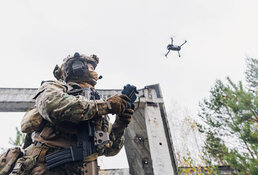DroneShield Ltd. (DRO:ASX; DRSHF:OTC) has announced a major expansion of its research and development (R&D) operations in the United States, reinforcing its commitment to next-generation counter-drone and electronic warfare technologies. The company will add a second site to its U.S. headquarters in Warrenton, Virginia, more than doubling its American workforce. Over 30% of the newly created positions will focus on software development and artificial intelligence (AI) applications.
This move follows recent expansions of DroneShield's production capacity in Australia and the opening of a new office in the European Union. According to DroneShield LLC CEO Matt McCrann in the news release, "As we continue to scale our operations globally, this expansion in the U.S. plays a crucial role in enhancing our ability to innovate and deliver advanced solutions for the evolving defense industrial base right here in the U.S."
The company stated that this investment will enhance its responsiveness to growing domestic and international demand for counter-unmanned systems (CUxS) capabilities, enabling faster product development cycles and increased service to its expanding base.
In addition to its defense applications, DroneShield has been expanding its reach into commercial counterdrone markets, including airports and critical infrastructure. The company’s investor materials referenced deployments configured specifically for civilian environments, reflecting rising global concerns over unauthorized drone activity. In late September, airports in Copenhagen and Oslo were forced to halt operations after drones disrupted flight paths, impacting thousands of passengers. According to Bloomberg, more than 30 planes were diverted and over 100 flights were canceled in Copenhagen alone. Authorities in both countries described the events as coordinated and possibly a demonstration of capability. These incidents underscore the growing need for scalable counterdrone solutions across both defense and civilian sectors.
Vice President of Sales and Business Development Tom Branstetter said the expansion demonstrates the company's increased commitment to U.S. customers, adding, "We're not just expanding our operations, we're doubling down on our commitment to providing best-in-class counter-drone solutions."
The expanded site will contribute to DroneShield's support of the U.S. Department of Defense's acquisition priorities in counter-drone technologies. Chief Product and Technology Officer Angus Bean emphasized that the expansion "strengthens our ability to support critical programs and deliver advanced solutions with greater speed and precision."
This announcement comes during a period of strong financial performance for the company. For the first half of 2025, DroneShield reported revenue of AU$72.3 million, a 210% increase compared to the same period in 2024, and the most profitable half-year in its history, with AU$5.2 million in profit before tax. As of August 2025, secured year-to-date revenue stood at AU$176.3 million, with a cash balance of AU$207.9 million.
The Rising Demands in Counter-Drone Defense
By September 2025, experts and military officials continued to underscore the rising significance of counter-unmanned aerial systems (C-UAS) in the aerospace and defense sector, citing urgent challenges posed by drone proliferation and evolving threats across multiple theaters of conflict.
Co-author Stacie Pettyjohn emphasized that "the United States risks having its distributed warfighting strategies overwhelmed by massed Chinese drone attacks," particularly in a potential conflict over Taiwan. She pointed to high-powered microwaves (HPMs) as the "technology most capable of defeating swarms and high-volume attacks," and noted that AI-enabled battle management systems were necessary for rapid threat detection and engagement.
On September 19, Pentagon News profiled the Joint Counter-Small Unmanned Aircraft Systems (C-sUAS) University at Fort Sill, Oklahoma, a dedicated training center for all U.S. military branches. Lt. Col. John Peterson, the university's director, explained that drone proliferation had transformed the battlespace, stating, "We've really seen the proliferation of drones at low altitudes that have speed and accuracy that we've never seen before." The report detailed training courses that prepared service members to operate fixed-site systems like the FS-LIDS (Fixed-Site Low, Slow, Small UAS Integrated Defeat System), as well as 3D-printed drone technologies used for cost-effective simulation. Army Maj. Dennis "Chip" Stanford noted that troops must now adopt "the mindset that everything is being observed from multiple angles," reflecting a broader shift in how battlefield awareness is being redefined.
According to a September 22 report by Inside Unmanned Systems, CNAS expanded on its earlier findings in a publication titled Countering the Swarm: Protecting the Joint Force in the Drone Age. The study described how small and medium drones had shifted from tactical tools to strategic threats capable of undermining U.S. force protection. The authors highlighted the cost imbalance between inexpensive enemy drones — such as a US$2,000 commercial quadcopter or a US$20,000 Shahed-136 — and U.S. interceptors costing hundreds of thousands to millions per engagement. "The stakes are not theoretical," the report warned. "Without adequate defenses, even the most advanced systems and tactics will be rendered irrelevant in the face of overwhelming drone attacks." The report called for scaled production of low-cost interceptors, expanded force-wide training, and greater institutional integration of counter-drone strategies.
Analysts Point to Profit Milestone and Expanding Pipeline
On August 28, Abraham Akra of Shaw and Partners reported that DroneShield Ltd. achieved record profitability in the first half of 2025, marking a significant turnaround from its net loss during the same period in 2024. Akra noted, "We see DRO reaching an inflection point in sales and profitability with the North Atlantic Treaty Organization agreement supplementing the U.S. Department of Defense recommendation and solidifying DroneShield as a market leader in jamming counter unmanned aircraft systems." Shaw and Partners maintained a Buy rating on the company and reiterated its target price of AU$3.60 per share, which implied a 12.5% upside from the trading level at the time.
According to the research note, DroneShield's H1/25 revenue was AU$72.3 million, a 210% year-over-year increase, while EBITDA reached AU$5.2 million. Gross profit margin stood at approximately 71%, and the company reported a net after-tax profit of AU$2.1 million. Cash receipts for the half totaled AU$60.7 million, representing a 185% year-over-year increase. As of June 30, 2025, the company held AU$204 million in cash and term deposits and reported no debt.
Akra highlighted DroneShield's continued manufacturing expansion, including a new 3,000-square-meter facility in Sydney and the development of manufacturing partnerships in the United States and the European Union. He wrote that "these systems underpin the delivery of next-gen hardware, increased software-as-a-service (SaaS) attach rates and repeat revenue across the product life cycle." By August, the company's staff had grown to 373, with 285 engineers supporting ongoing artificial intelligence software development.
The report also referenced DroneShield's expanded pipeline, which reached AU$2.34 billion across 310 projects. Of these, 13 projects were valued over AU$30 million, and 52 exceeded AU$5 million. Europe accounted for the largest portion of the pipeline. Although DroneShield was not selected for the Australian government's AU$45.9 million LAND 156 System Integration Partner contract, Akra remained positive on the company's future opportunities, including its potential participation in AU$1.3 billion of planned counterdrone acquisitions.
Akra projected that DroneShield would reach AU$213.4 million in revenue for the full year, up from AU$57.5 million in 2024, with most open orders expected to be fulfilled in the second half. Shaw and Partners revised its after-tax net profit forecasts upward by 2.6% for 2025 and 7.9% for 2026. Although the 2027 projection was adjusted downward by 5.6%, EBITDA estimates were maintained.
Embedded Growth in a Rapidly Expanding Sector
DroneShield's U.S. R&D expansion aligns with a broader strategic roadmap that includes growth across multiple verticals. The company reported an active sales pipeline of AU$2.34 billion as of August 2025, with 310 projects and 13 deals individually valued over AU$30 million.
According to the company's August 2025 investor presentation, global demand for counterdrone solutions is rising due to increasing geopolitical tensions and the growing role of unmanned systems in modern conflict. The U.S. Department of Defense has earmarked US$1.3 billion for counter-unmanned aerial systems (C-UAS) initiatives, highlighting the relevance of DroneShield's core technologies.
DroneShield's technology portfolio includes integrated hardware and proprietary AI-powered software for drone detection, classification, and neutralization. The company continues to invest over AU$50 million annually in R&D and now employs 373 people globally, including 285 engineers.
The U.S. expansion also supports the company's migration toward a software-as-a-service (SaaS) revenue model, which accounted for a 177% year-over-year increase in the first half of 2025. This growth is underpinned by the company's end-to-end CUxS solutions and its focus on embedding long-term partnerships with government and commercial customers.
 Streetwise Ownership Overview*
Streetwise Ownership Overview*
DroneShield Ltd. (DRO:ASX; DRSHF:OTC)
DroneShield's broader strategic priorities include establishing U.S. and European manufacturing hubs, launching next-generation hardware and software platforms, and expanding its presence in civilian markets as regulations evolve to support counterdrone purchases outside of defense.
Ownership and Share Structure
Recent filings reveal that Vanguard Group has become a substantial shareholder in DroneShield, holding a 5.45% stake, Fidelity Management and Research holds approximately 9.59% and State Street Corporation holds approximately 5.20%.
Management and insiders hold 1.30%, according to the company.
DroneShield has 874.72 million outstanding shares and 863.3 million free float traded shares. Its market cap is approximately AU$3.2 billion, and its sales pipeline has grown to AU$2.34 billion. The company's 52-week share price range is AU$0.59 to AU$4.39.
| Want to be the first to know about interesting Technology investment ideas? Sign up to receive the FREE Streetwise Reports' newsletter. | Subscribe |
Important Disclosures:
- As of the date of this article, officers and/or employees of Streetwise Reports LLC (including members of their household) own securities of DroneShield.
- James Guttman wrote this article for Streetwise Reports LLC and provides services to Streetwise Reports as an employee.
- This article does not constitute investment advice and is not a solicitation for any investment. Streetwise Reports does not render general or specific investment advice and the information on Streetwise Reports should not be considered a recommendation to buy or sell any security. Each reader is encouraged to consult with his or her personal financial adviser and perform their own comprehensive investment research. By opening this page, each reader accepts and agrees to Streetwise Reports' terms of use and full legal disclaimer. Streetwise Reports does not endorse or recommend the business, products, services or securities of any company.
For additional disclosures, please click here.











































